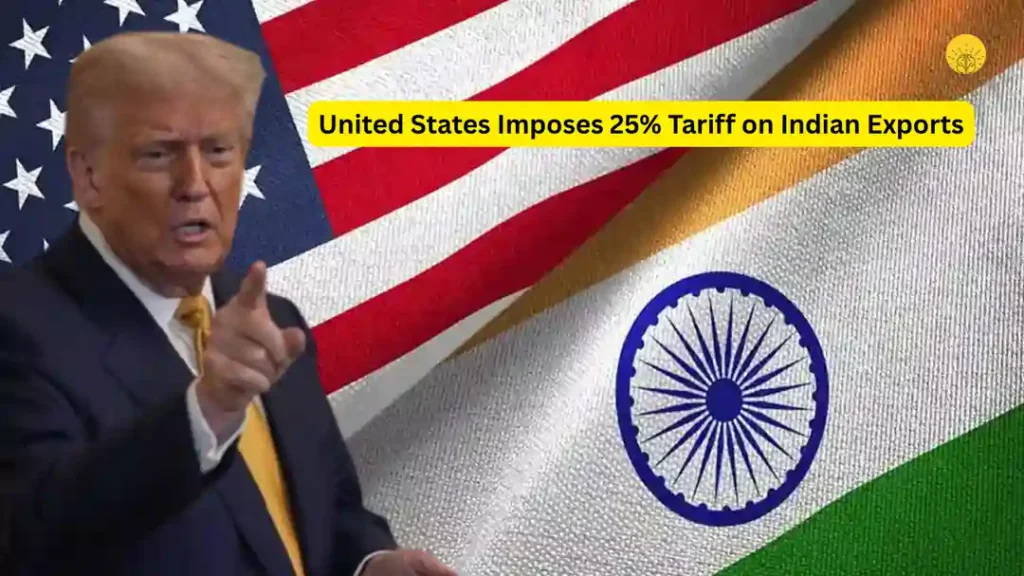New Delhi: The United States, under President Donald Trump, has announced a significant 25% tariff on all Indian goods effective August 1, 2025, coupled with an unspecified “penalty” targeting India’s trade relations with Russia. This move, which follows a previously proposed 26% reciprocal tariff in April 2025 that was put on hold, marks a new chapter in the strained trade relationship between the two nations. The decision has sparked widespread concern among Indian exporters, economists, and policymakers, with potential implications for bilateral trade, supply chains, and India’s economic growth.

Background: The U.S.-India Trade Relationship
The United States is India’s largest foreign export market, with bilateral trade reaching $131.8 billion in 2024, according to official data. Both nations have set an ambitious goal to more than double this figure to $500 billion by 2030 through a comprehensive Bilateral Trade Agreement (BTA). However, negotiations for even an interim “mini-deal” have faced significant hurdles, with key sticking points including India’s high tariffs, non-tariff barriers, and its trade and defense ties with Russia.
The U.S. goods trade deficit with India stood at $45.7 billion in 2024, a 5.4% increase from 2023, fueling U.S. concerns about trade imbalances. President Trump has repeatedly criticized India’s trade policies, describing its tariffs as “among the highest in the world” and its non-monetary trade barriers as “strenuous and obnoxious.” These barriers, particularly India’s agricultural subsidies and sanitary and phytosanitary (SPS) measures for food safety, have been cited as significant obstacles to U.S. exports.
Reasons for the Tariff Imposition
The U.S. decision to impose a 25% tariff on Indian exports, effective August 1, 2025, is driven by multiple factors, as outlined below:
1. Trade Deficit Concerns
The $45.7 billion U.S. trade deficit with India in 2024 has been a persistent point of contention. President Trump has prioritized reducing trade deficits with key partners, and India’s growing surplus has drawn scrutiny. The U.S. seeks greater market access for its goods, particularly in agriculture and dairy, sectors where India has maintained protective policies to safeguard its farmers and MSMEs (micro, small, and medium enterprises).
2. India’s Non-Tariff Barriers
India’s agricultural subsidies and SPS measures have been flagged as restrictive by the U.S. Trade Representative (USTR) Jamieson Greer. These measures, intended to ensure food safety and support Indian farmers, are viewed as barriers to U.S. agricultural exports. The U.S. has pushed for India to lower these barriers as part of trade negotiations, but India has held firm, prioritizing its domestic agricultural sector.
3. India’s BRICS Membership
India’s active participation in the BRICS bloc, which includes Brazil, Russia, India, China, and South Africa, has raised concerns in the U.S. The bloc is perceived as promoting anti-dollar policies, particularly through efforts to reduce reliance on the U.S. dollar in global trade. This geopolitical alignment has added friction to U.S.-India trade talks.
4. India-Russia Relations
A significant driver of the tariff decision is India’s continued trade with Russia, particularly in defense and energy sectors. The U.S. has expressed displeasure over India’s imports of Russian oil and military equipment, especially in light of the ongoing war in Ukraine. The proposed Russian Sanctions Act, 2025, aims to impose a staggering 500% duty on countries purchasing Russian oil or petroleum products, and the unspecified “penalty” announced alongside the 25% tariff is explicitly linked to India’s Russia ties. In a Truth Social post, President Trump stated, “I don’t care what India does with Russia. They can take their dead economies down together, for all I care,” signaling his frustration with India’s refusal to align with U.S. sanctions on Russia.
The Tariff Announcement: Details and Reactions
On July 31, 2025, President Trump announced the 25% tariff on Indian goods, effective immediately, via his Truth Social platform. Describing India as a “friend,” he nonetheless criticized its high tariffs and non-tariff barriers, stating, “Over the years, we have done relatively little business with them because their Tariffs are far too high, among the highest in the World.” The additional penalty for India’s trade with Russia remains unspecified, creating uncertainty for Indian exporters.
The Indian government responded cautiously, with the Ministry of Commerce and Industry stating it is “studying the implications” of the announcement. The ministry reiterated its commitment to a “fair, balanced, and mutually beneficial” BTA while emphasizing the protection of India’s farmers, entrepreneurs, and MSMEs. Indian negotiators face mounting pressure to secure a deal that addresses U.S. concerns without compromising national interests.
Political Reactions
The tariff announcement has drawn sharp criticism from India’s opposition Congress party. Congress MP Imraan Masood accused the government of failing to counter U.S. pressure, stating, “The more we are trying to bow down to America, the more they are trying to dominate us. Our country’s diplomacy and foreign policy are both being mocked.” Congress also referenced Prime Minister Narendra Modi’s 2019 U.S. rally in support of Trump, calling the tariffs a “catastrophic failure of foreign policy.”
The Iranian Embassy in India also weighed in, condemning the U.S. for “weaponizing the economy” and using sanctions to “dictate its will on independent nations such as Iran and India.” This statement underscores the broader geopolitical tensions surrounding the tariffs.
Industry and Economic Concerns
Indian exporters, represented by organizations like the Federation of Indian Export Organisations (FIEO), have expressed alarm over the tariffs. FIEO President S.C. Ralhan noted that U.S. buyers are already canceling or holding back orders pending clarity on the penalty component. Key export sectors, including pharmaceuticals (India is the largest supplier of non-patented drugs to the U.S.), textiles, leather, marine products, and automobiles, are expected to face significant challenges.
Economists have warned of broader economic impacts. Aditi Nayar, chief economist at ICRA, stated that the tariffs and penalties “are likely to pose a headwind to India’s GDP growth,” with the extent depending on the penalty’s severity. ICRA had already lowered India’s GDP forecast for the fiscal year from 6.5% to 6.2% due to earlier tariff concerns. Nomura estimated a 0.2% GDP hit, describing the tariffs as “growth negative.” Indian stock markets opened in the red on August 1, reflecting investor concerns.
Competitive Disadvantage and Supply Chain Disruptions
The 25% tariff places India at a competitive disadvantage compared to other Asian economies. For instance, Vietnam faces a 20% tariff, Indonesia 19%, and China recently negotiated a reduction from 145% to 30%. These lower tariffs make competitors more attractive for U.S. buyers, potentially diverting supply chains away from India in sectors like textiles, where India had hoped to gain market share.
The tariffs are also expected to inflate costs and delay shipments, disrupting supply chains. Exporters may need to renegotiate prices with U.S. buyers, potentially absorbing part of the 25% tariff to remain competitive, which could erode profit margins. Agneshwar Sen, a trade policy expert at EY India, highlighted the impact on sectors with robust bilateral trade, such as pharmaceuticals and automobiles.
Geopolitical Context: India’s Russia Ties
India’s relationship with Russia has been a flashpoint in U.S.-India trade talks. Since the Ukraine conflict began, India has defended its historic ties with Russia and its oil purchases, arguing that as an energy-import-dependent nation, it must secure the best prices to protect its citizens. India’s reliance on Russian arms has decreased over time, but defense cooperation remains significant. President Trump’s decision to link trade penalties to India’s Russia ties introduces a new layer of complexity to negotiations, as noted by Mark Linscott of the US India Strategic Partnership Forum. Linscott emphasized that India’s sovereign right to choose its trade partners is a key sticking point.
The Path Forward: Bilateral Trade Agreement
Despite the tensions, both India and the U.S. have expressed a commitment to continue trade negotiations. A U.S. team is expected to visit India in late August to work toward a comprehensive BTA by the fall deadline. Industry leaders, such as FICCI President Harsha Vardhan Agarwal, remain hopeful that the tariffs are a “short-term phenomenon” and that a permanent deal will be finalized soon.
However, challenges remain. India’s insistence on protecting its agriculture and dairy sectors clashes with U.S. demands for broader market access. Trump’s unpredictable rhetoric, including his claim that India’s economy is “dead,” adds uncertainty to the process. Linscott suggested that direct negotiations between Prime Minister Modi and President Trump, including commitments on energy and military purchases, could be key to breaking the impasse.
Economic Resilience and Policy Responses
While the tariffs pose a challenge, India’s relatively domestic-oriented economy may mitigate some of the impact. Nomura noted that India is less reliant on goods trade than other Asian peers, which could limit the economic fallout. However, the tariffs may prompt India’s central bank to consider deeper rate cuts to support growth, as suggested by Nomura.
Indian negotiators face the daunting task of balancing national interests with the need to maintain access to the U.S. market, which accounts for roughly one-fifth of India’s exports. A best-case scenario, according to Nomura, would see tariffs reduced to 15-20% through negotiations, though this is still higher than anticipated given the advanced stage of talks.
Conclusion
The U.S. imposition of a 25% tariff on Indian exports, coupled with an unspecified penalty for India’s Russia ties, marks a significant escalation in trade tensions. The move threatens India’s export sectors, economic growth, and supply chains while complicating efforts to secure a Bilateral Trade Agreement. As Indian negotiators work to address U.S. concerns without compromising national interests, the coming months will be critical for shaping the future of U.S.-India trade relations. With both sides committed to a $500 billion trade goal by 2030, there remains hope that diplomacy and negotiation can pave the way for a mutually beneficial resolution.
Frequently Asked Questions (FAQs)
1. Why has the United States imposed a 25% tariff on Indian goods starting August 1, 2025?
The U.S. imposed the 25% tariff due to a combination of factors: a $45.7 billion U.S. trade deficit with India in 2024, India’s high tariffs and non-tariff barriers (such as agricultural subsidies and sanitary measures), its membership in the BRICS bloc (seen as anti-dollar), and its continued trade with Russia, particularly in oil and defense. An additional unspecified penalty targets India’s Russia ties, linked to the proposed Russian Sanctions Act, 2025, which aims to impose 500% duties on countries buying Russian oil or petroleum products.
2. How will the 25% tariff and penalty affect Indian exports and the economy?
The tariffs will increase costs for Indian goods in the U.S., India’s largest export market, potentially reducing demand in key sectors like pharmaceuticals, textiles, leather, marine products, and automobiles. Exporters may need to lower prices to stay competitive, impacting profit margins. Economists estimate a 0.2% hit to India’s GDP, with ICRA lowering its growth forecast from 6.5% to 6.2%. Supply chain disruptions and order cancellations by U.S. buyers are already reported, and India faces a competitive disadvantage compared to countries like Vietnam (20% tariff) and Indonesia (19%).
3. What is the unspecified penalty mentioned in the tariff announcement?
The penalty, announced by President Trump, is linked to India’s purchases of Russian oil and military equipment. Its details remain unclear, causing uncertainty for exporters. The Federation of Indian Export Organisations (FIEO) is awaiting the U.S. executive order for clarity. The penalty is part of broader U.S. efforts to pressure countries trading with Russia, especially amid the Ukraine conflict.
4. How is India responding to the U.S. tariffs?
India’s Ministry of Commerce and Industry is studying the tariffs’ implications and remains committed to a “fair, balanced, and mutually beneficial” Bilateral Trade Agreement (BTA). India is prioritizing the welfare of its farmers, entrepreneurs, and MSMEs, maintaining firm stances on protecting agriculture and dairy. Negotiations for a comprehensive BTA are set to continue, with a U.S. team expected in India in late August to meet the fall deadline for a deal.
5. What are the prospects for resolving the trade tensions between India and the U.S.?
Despite the tensions, both nations aim to increase bilateral trade to $500 billion by 2030, suggesting room for negotiation. Industry leaders hope the tariffs are temporary, and a permanent BTA could lower tariffs to 15-20%. However, India’s refusal to compromise on agriculture and its Russia ties, combined with Trump’s unpredictable rhetoric, complicates talks. Direct negotiations between Prime Minister Modi and President Trump could be key to securing a deal, potentially involving commitments on energy and military purchases.

